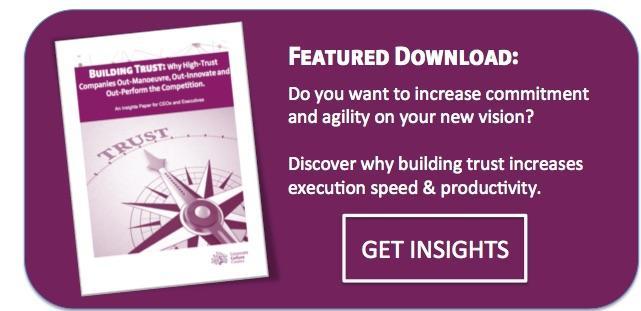Have you ever unintentionally threatened people? What about in a business meeting? I did that recently. Let me share how I did it, so you don’t make the same mistake I did.
It all started so innocently…..
A senior leader from a large organisation requested my help. It was to strategize tactics to embed trust into their new people strategy. In a meeting, we discussed challenges and recent employee engagement survey results. Despite some positive feedback, a glaring warning sign was employees felt under-valued. They believed they had limited autonomy and the culture valued results over people. Furthermore, leaders exhibited inconsistent behaviours and failed to ask and act on feedback. All chronic trust issues.
A week later I proposed a plan to provide leaders with more in-depth knowledge of trust building.
After all, trust means different things to different people. One of the reasons companies struggle to build trust is that leaders don’t have a common language to talk about it constructively.
Leaders were scrambling to work out appropriate strategies. A workshop was proposed to give leaders a new leadership tool to build trust quickly. Followed by a strategy session to brainstorm the right trust activities.
Seems pretty simple, right?
Wrong. Unintentionally, I had written a proposal that was a death trap.
The document was an honest assessment of their situation. It pointed out the problem with some restraint and highlighted positive behaviours. Fatal flaw. Both the leader and HR manager visibly panicked. Defensiveness set in and some refuting of what we had discussed. Despite their recent poor survey results that glared in front of us.
The irony? Our discussion to improve psychological safety was halted. Both the leader and HR manager no longer felt safe to openly discuss the chronic issues. They seemed okay to discuss their challenges in the first meeting. But in the second meeting, they closed down. What’s worse was they didn’t realise that by being afraid of speaking the truth indicated how bad things were. It was even feeding the problem.
Now, you’re probably thinking “Oh, I wouldn’t do that. I would be totally okay with discussing what’s going on and having a written proposal that could be traced back to me and my opinions. I’m sure my boss would be okay with that and wouldn’t hang me out to dry.”
But you wouldn’t. Not unless you’re working in a 100% safe environment. Or the CEO of a company (willing to address your own flawed culture). For most of you, the amygdala, the alarm bell in the brain, is screaming: “I’m going to die. I’m going to die. I’ve just made the worst career decision ever. Help me. Quick, shut the witch down, before my boss comes in and throws us out onto the street.”
My two prospective clients were in complete fight-or-flight response mode. Their brains were hijacked. They now operated on “act first, think later.”
It shut down perspective and analytical reasoning. As well as any hope for a deep discussion or solution. Quite literally, they had lost their minds in response to what their brain now believed was a life-or-death situation. Sitting in their hands, my magenta and green proposal, was literally making my prospective clients scream inside their heads “She’s going to kill us all. This proposal is evil!”
I might as well have been standing there with a noose ready to take them to the hanging block.
What is Psychological Safety?
Psychological safety is when we feel
safe enough to be ourselves. We can speak up about what’s going on without fear of
being punished
.
Paradoxically
, research has found the safer people feel the more they take risks and make mistakes
. This empowers people to share crazy ideas, rather than cling to the status quo. It also improves collaboration and sharing of information. All the types of behaviours required for market breakthroughs. Oh, and building a high trust environment.
But it is quite fragile. As I experienced, when I provocatively repeated back to leaders some of the issues they had told me about that were depleting morale.
When people don’t feel safe, they take safety away from others. They react angrily. Refuse to communicate, in order to control the environment. And they search for meaning and symbols that potentially indicate hidden threats. They also ignore ideas and feedback. Self-preservation rules.
The problem isn’t so much the content of the conversation, it’s the environment.
In today’s fast paced environment, success depends on leaders who encourage employees to operate from a more optimal brain state. One in which they can respond from choice rather than fear. A place where people are positive and open to change. Where they can solve complex problems and foster cooperative relationships. To do this our brains need to feel safe first before they can trust.
But the trick is how does an organisation improve psychological safety when they are too scared to talk about it?
The answer is they can’t.
Unless you have a strong CEO who has the courage and commitment to push the initiative through. This means doing everything in their power to demonstrate that the environment is secure. Without this commitment from the CEO (and a leadership team willing to look truthfully at themselves), psychological safety is a pipe dream. It’s too dangerous for our brains to contemplate.
Not all companies are willing or able to go that far. In general, it’s smaller, younger, more entrepreneurial companies willing to embrace new ideas. In other words, companies not dragged down by years of command and control leadership. The results are staggering. According to Imperative Research, high trust companies have 2.5 times the revenue of low trust companies. They’re also more productive, innovative and have higher levels of customer satisfaction.
Lessons Learned
I’ve always thought of myself as a gentle-mannered, easy-going kind of a gal. Sure, I get cranky when it hits 12.30pm and I’m not eating lunch. I get antsy when I can’t get a soy cappuccino with lots of froth and a big oversized shake of cocoa powder. But I’ve never considered myself dangerous, frightening or even revolutionary.
But just like any bespectacled superhero, I am willing to make the world a better place. To protect the weak. To support company visions that are life-changing. And to enhance trust leadership capabilities. Damm it! I want people to have fun at work, to love what they do and to feel safe in speaking up.
And if that means frightening the bejesus-es out of corporate Australia and getting them to look at themselves. Fair enough!
Am I sorry that I wrote a “warts and all” proposal that exposed the truth? Quite frankly, no!
Downplaying the truth or sugar coating it is what low trust people do. What often gives consultants a bad name is those who will say anything for money. These are exactly the sorts of behaviours that need to be weeded out. It’s the antithesis of an authentic and high integrity workplace. My approach might appear naive, but if we are too afraid to call out bad behaviours, how are we ever going to deal with them?
But like any true superhero with a business mind, I’ve learnt my lesson and I have changed my game plan. No point in freaking people out and putting them in fear.
What about you? What experiences have you had where psychological safety was too big of a threat for people to admit the truth?



